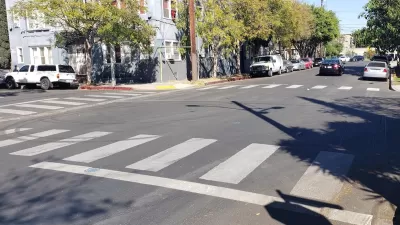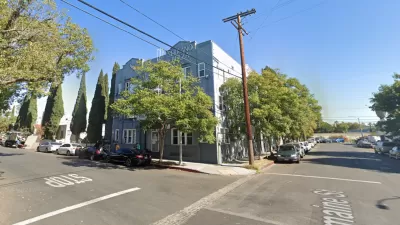Fed up with speeding cars, and a city bureaucracy seen as slow to respond to their complaints, residents and artists in Baltimore have taken it upon themselves to remedy the situation by creating their own traffic calming measures.
As Baltimore officials pull the plug on a troubled speed and red-light camera system, the city's residents have discovered cheaper, but illicit, means of calming traffic. A small potted tree, a steel sculpture, and a “snowmom” and two snow children wearing orange vests are among the tactical interventions that have appeared along the city's dangerous streets to attract attention and slow drivers.
"Painting the street, playing ball in the street, decorating the yard, murals, sculptures—basically anything that creates visual interest and surprise—also slows down vehicular traffic," writes David Engwicht, urban designer and author of Street Reclaiming, a guide to addressing neighborhood traffic problems.
"Engwicht advises his readers to make obstacles temporary and not to ask permission," notes Edward Ericson Jr. "Several Baltimoreans have followed Engwicht’s prescriptions, though none had heard of the author."
“You go through the dumb bureaucratic ladder with the city, it’s gonna take 10 years and they’re gonna put something stupid,” says Matt Fouse, a Charles Village artist who created one of the illicit interventions. “It’s easier to ask forgiveness than permission. That’s the motto of my life.”
FULL STORY: STREET THEATER

Maui's Vacation Rental Debate Turns Ugly
Verbal attacks, misinformation campaigns and fistfights plague a high-stakes debate to convert thousands of vacation rentals into long-term housing.

Planetizen Federal Action Tracker
A weekly monitor of how Trump’s orders and actions are impacting planners and planning in America.

San Francisco Suspends Traffic Calming Amidst Record Deaths
Citing “a challenging fiscal landscape,” the city will cease the program on the heels of 42 traffic deaths, including 24 pedestrians.

Defunct Pittsburgh Power Plant to Become Residential Tower
A decommissioned steam heat plant will be redeveloped into almost 100 affordable housing units.

Trump Prompts Restructuring of Transportation Research Board in “Unprecedented Overreach”
The TRB has eliminated more than half of its committees including those focused on climate, equity, and cities.

Amtrak Rolls Out New Orleans to Alabama “Mardi Gras” Train
The new service will operate morning and evening departures between Mobile and New Orleans.
Urban Design for Planners 1: Software Tools
This six-course series explores essential urban design concepts using open source software and equips planners with the tools they need to participate fully in the urban design process.
Planning for Universal Design
Learn the tools for implementing Universal Design in planning regulations.
Heyer Gruel & Associates PA
JM Goldson LLC
Custer County Colorado
City of Camden Redevelopment Agency
City of Astoria
Transportation Research & Education Center (TREC) at Portland State University
Jefferson Parish Government
Camden Redevelopment Agency
City of Claremont





























